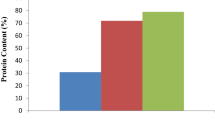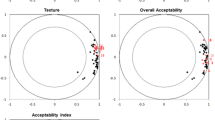Abstract
The efforts for promoting the consumption of food of plant origin are increasingly growing. The amaranth grain is an important vegetable protein source, superior in content and quality to traditional cereals. In the central-west region of Argentina, new amaranth varieties have been obtained to optimize its agronomic traits and promote its use. In this work, the analysis of the wholemeal flour protein from seeds of two new varieties of Amaranthus cruentus var. Candil (CC) and Amaranthus hypochondriacus var. Dorado (HD), as well as from advanced lines of Amaranthus hypochondriacus x Amaranthus cruentus H17a (H17) and Amaranthus cruentus G6/17a (CG6), was carried out in order to elucidate their nutritional contribution to human diet. The amino acids profile and the chemical score (CS) were determined, and the protein quality was evaluated in-vivo through the following indexes: net protein utilization (NPU), true digestibility (tD), biological value (BV) and protein digestibility corrected amino acid score (PDCAAS). In general, the amino acids values of the different varieties exceeded the requirements established by the WHO/FAO/UNU; however, valine was the limiting amino acid in all cases. The values obtained (%) were within the following ranges: NPU, 33.56–46.04 %; tD, 68.80–75.40 %; BV, 44.53–64.28%; and PDCAAS, 23.69–36.19 %. These results suggest that the new amaranth flours varieties can be adequate for human consumption and as complementary protein source.
Similar content being viewed by others
Abbreviations
- AAS:
-
Amino acid score
- AIN-93G:
-
American Institute of Nutrition 1993 for growth
- AOAC:
-
Association of Official Analytical Chemists
- BV:
-
Biological value
- CC:
-
Amaranthus cruentus var. Candil
- CG6:
-
Amaranthus cruentus G6/17a
- CS:
-
Chemical score
- H17:
-
Amaranthus hypochondriacus x Amaranthus cruentus H17a
- HD:
-
Amaranthus hypochondriacus var. Dorado
- NPU:
-
Net protein utilization
- PDCAAS:
-
Protein digestibility corrected amino acid score
- tD:
-
True digestibility
- WHO/FAO/UNU:
-
World Health Organization/ Food and Agriculture Organization of the United Nations/ United Nations University
References
National Research Council (1989) Lost crops of the incas: little-known plants of the andes with promise for worldwide cultivation. National Academy Press, Washington, DC. ISBN 0-309-04264-X
Bressani R (1994) Composition and nutritional properties of amaranth. Amaranth, biology, chemistry and technology. Paredes-López O, Editor. CRC Press, Boca Ratón, Florida, pp 185–206. ISBN: 0849353742
Ballabio C, Uberti F, Di Lorenzo C, Brandolini A, Penas E, Restani P (2011) Biochemical and immunochemical characterization of different varieties of amaranth (Amaranthus L. ssp.) as a safe ingredient for gluten-free products. J Agric Food Chem 59:12969–12974. doi:10.1021/jf2041824
de la Barca AM, Rojas-Martínez ME, Islas-Rubio AR, Cabrera-Chávez F (2010) Gluten-free breads and cookies of raw and popped amaranth flours with attractive technological and nutritional qualities. Plant Foods Hum Nutr 65:241–246. doi:10.1007/s11130-010-0187-z
Alvarez-Jubete L, Auty M, Arendt E, Gallagher E (2010) Baking properties and microstructure of pseudocereal flours in gluten-free bread formulations. Eur Food Res Technol 230:437–445
Gupta C, Sehgal S (1992) Protein quality of developed home made weaning foods. Plant Foods Hum Nutr 42:239–246
AOAC (2006) Official Methods of Analysis of AOAC International, 18th edn. Association of Official Analytical Chemists (AOAC), Gaithersburg, MD
WHO/FAO/UNU (2007) Protein and amino acid requirements in human nutrition report of a joint WHO/FAO/UNU expert consultation. Series 935 World Health Organization. Geneva, Chapter 6, Protein Quality Evaluation, pp 95
Mitchell HH, Block RJ (1946) Some relationships between the amino acid contents of proteins and their nutritive values for the rat. J Biol Chem 163:599–620
Miller DS, Bender AE (1955) The determination of the net utilization of proteins by a shortened method. Brit J Nutr 9:382–388
Pellet PL, Young VR (1980) Nutritional evaluation of protein foods. Tokyo: The United Nations University. (Publication N° WHTR-3/UNUP-129) Japan
Reeves PG, Nielsen FH, Fahey GC Jr (1993) AIN-93 Purified diets for laboratory rodents: final report of the American Institute of Nutrition Ad Hoc writing committee on the reformulation of the AIN-76A rodent diet. J Nutr 123:1939–1951
FAO/WHO (1991) Protein quality evaluation. Report of the joint FAO/WHO expert consultation. Rome: FAO Food and Nutrition Paper No. 51. ISBN: 92-5-103097-9
Pascale R, Lamghari R, Linder M, Villaume C, Jacques F, Parmentier M, Méjean L (1997) In vivo and in vitro digestibility of soybean, lupine and rapeseed meal proteins after various technological processes. J Agric Food Chem 45:1762–1769
Snedecor GW, Cochran WG (1991) Statistical Methods, 8th Ed., Wiley. ISBN: 0813815614, 9780813815619
Bressani R (2003) Amaranth. Encyclopedia of food sciences and nutrition. In: Caballero B (ed) 2nd edn. Academic Press, Oxford, pp 166–173. ISBN: 978-0-12-227055-0
Alvarez-Jubete L, Arendt EK, Gallagher E (2009) Nutritive value and chemical composition of pseudocereals as gluten-free ingredients. Int J Food Sci Nutr 60:240–257
Menegassi B, Pilosof AMR, Arêas JAG (2011) Comparison of properties of native and extruded amaranth (Amaranthus cruentus L. - BRS Alegria) flour. LWT-Food Sci Technol 44:1915–1921. doi:10.1016/j.lwt.2011.04.008
Aguilar EG, Peiretti EG, Uñates MA, Marchevsky EJ, Escudero NL, Camiña JM (2013) Amaranth seed varieties. A chemometric approach. Food Measure 7:199–206. doi:10.1007/s11694-013-9156-1
Mucciarelli SI, Arellano ML, Cid JA, Lúquez NG, Fernández S (1990) Composición química y valor nutritivo de la proteína de Amaranthus quitensis. Arch Latinoam Nutr 40:69–74. ID: mdl-2103717. ISSN: 0004–0622
de Arellano ML, Fernández S, Luco J, Escudero N, Petenatti E, Mucciarelli SI (1996) Composition and biological evaluation of Amaranthus standleyanus L. seed flour. Sci Aliment 16:289–296. ISSN: 0240 CODEN SCALDC http://agris.fao.org/aos/records/FR9607128
Paredes López O (1999) Molecular biotechnology for plant food production. CRC Press, Lancaster, Pennsylvania. ISBN 10: 1566766850 / ISBN 13: 9781566766852
Amino-acid content of foods and biological data on proteins. Food and Agriculture Organization of the United Nations Rome – Italy. FAO 1970. http://www.fao.org/docrep/005/AC854T/AC854T00.htm
Mendoza MC, Bressani R (1987) Nutritional and functional characteristics of extrusion-cooked amaranth flour. Cereal Chem 64:218–222. http://www.aaccnet.org/publications/cc/backissues/1987/Documents/64_218.pdf
Escudero NL, Arellano ML, Luco J, Gimenez MS, Mucciarelli S (2004) Comparison of the chemical composition and nutritional value of Amaranthus cruentus flour and protein concentrate. Plant Foods Hum Nutr 59:15–21
Belton PS, Taylor JRN (2002) Pseudocereals and less common cereals grain properties and utilization potential. Springer-Verlag Berlin Heidelberg, New York. ISBN: 3-540-42939-5
Kannan S, Nielsen SS, Mason AC (2001) Protein digestibility corrected amino acid scores for bean and bean–rice infant weaning food products. J Agric Food Chem 49:5070–5074
Suárez López MM, Kizlansky A, López LB (2006) Evaluación de la calidad de las proteínas en los alimentos calculando el escore de aminoácidos corregido por digestibilidad. Nutr Hosp 21:47–51
Acknowledgments
We are grateful to Engineer Guillermo Peiretti (Professor of the Agronomical and Veterinary Sciences, Department National University of Río Cuarto) for kindly providing the seeds employed in this work, obtained as original varieties from experimental cultivation. We also want to thank the UNSL, UNLPam and CONICET.
Conflict of interest
All authors confirmed that they have no conflict of interest.
Author information
Authors and Affiliations
Corresponding author
Rights and permissions
About this article
Cite this article
Aguilar, E.G., Albarracín, G.d., Uñates, M.A. et al. Evaluation of the Nutritional Quality of the Grain Protein of New Amaranths Varieties. Plant Foods Hum Nutr 70, 21–26 (2015). https://doi.org/10.1007/s11130-014-0456-3
Published:
Issue Date:
DOI: https://doi.org/10.1007/s11130-014-0456-3




